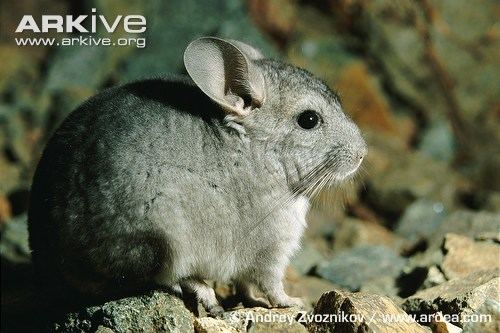Mass 1.1 – 1.4 kg (Adult) Tail length 10 cm (Adult) Rank Species | Phylum Chordata Scientific name Chinchilla chinchilla Length 28 – 49 cm (Adult) Higher classification Chinchilla | |
 | ||
Similar Chinchilla, Rodent, Chinchillidae, Long‑tailed chinchilla, Domestic chinchilla | ||
The short-tailed chinchilla (Chinchilla chinchilla, formerly known as Chinchilla brevicaudata), also called the Bolivian, Peruvian, or royal chinchilla, is an endangered species of rodent. Their original range included the Andes Mountains of Argentina, Chile, Peru, and Bolivia. The rodents were exploited for their luxurious fur, causing their numbers to dwindle greatly.
Contents

Characteristics
Chinchillas’ bodies measure between 28 and 49 cm long and weigh around 38 to 50 ounces. They have short front legs and long, powerful hind legs that aid in climbing and jumping. Short-tailed chinchillas have thicker necks and shoulders and have much shorter tails than their long-tailed relatives.
Ecology

In the wild, chinchillas burrow under rocks or in the ground for shelter. They mostly live in colder climates for which they are well adapted because of their dense fur. They mostly feed upon vegetation. They are social animals living in colonies or herds; chinchillas usually have litters of one or two offspring.
Commercialization
Many chinchillas are bred in captivity for their fur, which is very fine and dense, and is in high demand in the fur industry. Commercial hunting began in 1829 and increased every year, by about half a million skins annually, as fur and skin demand increased in the United States and Europe. “The continuous and intense harvesting rate, however, was not sustainable and the number of chinchillas hunted declined until the resource was considered economically extinct by 1917". Hunting chinchillas became illegal in 1929, but laws were not effectively enforced until 1983.
Conservation
Because of the impending extinction of short-tailed chinchillas, conservation measures were implemented in the 1890s in Chile. However, these measures were unregulated. The 1910 treaty between Chile, Bolivia, Argentina, and Peru brought the first international efforts to ban hunting and commercialization of chinchillas. Unfortunately, this effort led to great price increases, thus led to the further decline of the remaining populations. The first successful protection law passed in Chile was not until 1929. Today, both the short-tailed and long-tailed chinchillas are listed as “endangered” both in Chile and by the IUCN. Because of successful reproduction in captive environments, chinchillas are less hunted in the wild.
